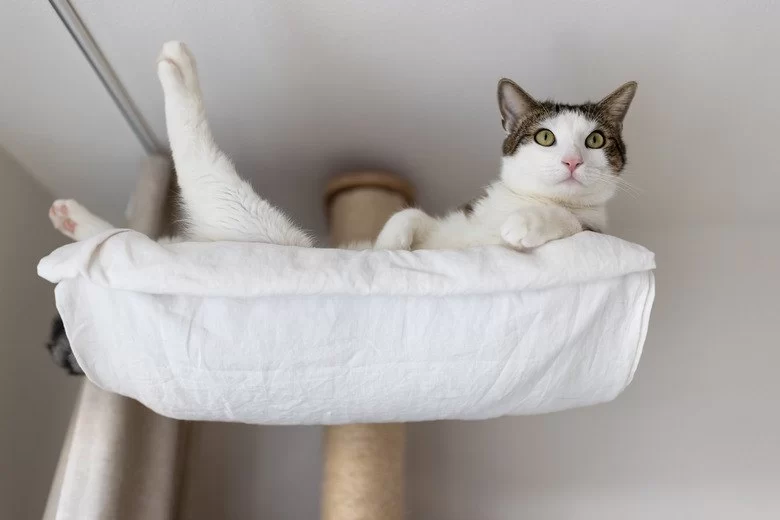- understanding-your-cats-sleeping-behavior
- the-instinct-to-seek-strange-spots
- cat-sleeping-in-odd-places-for-safety
- temperature-comfort-and-environment
- stress-anxiety-and-environmental-triggers
- real-case-mittens-in-the-bookshelf
- when-sleeping-spots-could-indicate-a-health-issue
- creating-safe-and-comfortable-sleeping-options
- when-to-contact-a-veterinarian
1. Understanding Your Cat’s Sleeping Behavior
1.1 The Nature of Feline Napping
Cats are notorious for their impressive sleeping habits—averaging 12 to 16 hours a day. But when your feline suddenly chooses a laundry basket, the bathtub, or even a shoe box over its cozy bed, many pet owners wonder why. A cat sleeping in unusual places is usually acting on instinct, curiosity, or subtle environmental cues.
1.2 Is It Normal?
For the most part, yes. Cats often select odd places to nap for reasons that seem logical to them, even if baffling to us. However, when it becomes persistent or is coupled with other behavioral changes, it could warrant deeper attention.
2. The Instinct to Seek Strange Spots
2.1 Natural Predatory and Survival Instincts
In the wild, cats often hide in enclosed, unpredictable places to rest—this keeps them safe from predators and allows them to stalk prey. Your domestic cat may not face wild threats, but the instinct remains. That tight corner under the bed? It feels like the perfect hidden den.
2.2 Independence and Control
Cats are famously independent creatures. Choosing their own sleeping spot is a small way they assert control over their environment. Especially in multi-pet homes, this helps them find peace and ownership over space.
3. Cat Sleeping in Odd Places for Safety
3.1 Secure Spaces Bring Comfort
Many cats choose closets, boxes, or even behind the couch cushions because these areas feel safe. Enclosed spaces offer protection from perceived dangers or disruptions like loud children, dogs, or guests.
3.2 Avoiding Overstimulation
If your cat is overwhelmed by activity in the home, it may seek out low-traffic areas. A high shelf or behind the curtains offers solitude and a break from overstimulation.
4. Temperature, Comfort, and Environment
4.1 Chasing Warmth or Coolness
Have you found your cat sleeping on the bathroom tiles in summer, or curling up by the heater in winter? Cats are temperature-sensitive. Their choices often reflect their effort to regulate body heat. A seemingly “weird” place might be the most thermally comfortable spot in your home at that moment.
4.2 Sunbeams and Drafts
From sun-drenched window sills to vent grates, cats are experts at finding climate zones. Their behavior can even indicate where your home may have ventilation issues or hidden drafts.
5. Stress, Anxiety, and Environmental Triggers
5.1 Change in Routine
New pets, visitors, moving furniture, or construction noise can cause stress, leading cats to alter sleeping habits. It’s not uncommon for a cat to suddenly start sleeping in the closet after a noisy vacuuming session or a move to a new apartment.
5.2 Marking “Safe Zones”
Cats use scent to mark their territory. Sleeping in different spots may be their way of reasserting control and safety over their space, especially if new animals or humans are involved.
6. Real Case: Mittens in the Bookshelf
6.1 The Story
Mittens, a tabby cat from Vermont, baffled her owner by suddenly abandoning her plush cat bed in favor of the top shelf of the bookshelf. At first, her owner thought it was quirky behavior. But when a visiting puppy disrupted Mittens’ routine, it all made sense. The bookshelf was quiet, high, and completely out of reach from the excitable pup.
6.2 What We Can Learn
Cats often choose sleeping spots based on their need for peace, safety, and routine. Their behavior is responsive, not random.
7. When Sleeping Spots Could Indicate a Health Issue
7.1 Hiding More Than Normal
If your cat begins to sleep in increasingly hidden or hard-to-reach places, and shows other signs like reduced appetite, lethargy, or avoidance, it may signal illness or discomfort. Cats instinctively hide weakness, so unusual sleeping patterns may be an early sign something is wrong.
7.2 Sudden Change in Sleeping Behavior
Pay attention to abrupt changes. If your previously social cat now isolates itself to nap constantly in closets or laundry piles, schedule a check-up. Sudden shifts in behavior are worth investigating.
8. Creating Safe and Comfortable Sleeping Options
8.1 Give Choices
Offer various types of beds—soft, enclosed, elevated—to let your cat choose. Place them in quiet, accessible spots. Rotating locations occasionally can refresh interest while still respecting your cat’s sense of safety.
8.2 Respect Their Preferences
Don’t try to force your cat to sleep in one designated bed. Cats prefer to make their own decisions. Observe what textures and locations they gravitate toward and try to replicate that comfort.
9. When to Contact a Veterinarian
9.1 Monitoring Behavioral Patterns
If strange sleeping behavior is paired with physical or behavioral changes—hiding more, eating less, or being more vocal—consult your vet. These could be signs of pain or emotional distress.
9.2 Support from Local Experts
If in doubt, consult a local pet care provider. Hidden Brook Veterinary offers thoughtful, compassionate care and can help assess whether your cat’s behavior is quirky, or a sign of something deeper.












